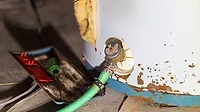New interest in old broken pipes
Last month, the U.S. Senate passed the $10.6 billion Water Resources Development Act whose overwhelming 95-3 vote shows broad bipartisan support.

Aided by the health crisis in Flint, Mich., and the upcoming election, efforts to fix the nation’s water infrastructure have captured politicians’ attention. Last month, the U.S. Senate passed the $10.6 billion Water Resources Development Act whose overwhelming 95-3 vote shows broad bipartisan support.
While this action represents a positive step, it’s a mere drop in the bucket of the work that needs to be done. The American Society of Civil Engineers states only 30% of U.S. water and wastewater infrastructure needs between 2016 and 2025 are funded, leaving an investment gap of $105 billion.
The bill next goes to the House where congressmen want to fashion their own — reportedly leaner — version before an agreement is reached by the end of the year with the Senate. The Senate bill authorizes about 30 infrastructure projects for navigation, port improvements, flood control and environmental restoration, as well as $4.9 billion for drinking and clean water infrastructure over the next five years. The bill includes:
-
$220 million in emergency funding for communities such as Flint, which have experienced lead contamination in their water supplies;
-
$70 million to finance costs for up to $1 billion in secured loans for water infrastructure through the Water Infrastructure Finance and Innovation Act Fund at the EPA;
-
$17.5 million for a lead-exposure registry to monitor the effects on children; and
-
$2.5 million for an advisory committee to review ways to reduce lead exposure.
The deplorable condition of our public water systems is well-known, of course. The ASCE issues its report card on the nation’s infrastructure every four years with water and wastewater each earning a D grade in 2013. This actually represents an improvement from a D- in 2009.
ASCE this year issued an update to its report: “Failure to Act: Closing the Infrastructure Investment Gap for America’s Economic Future.” Although published before the Senate passed its bill, ASCE’s estimate of the $105 billion investment needed for water and wastewater systems covers roughly the same years as the Senate bill’s funding of $10.6 billion.
Plumbing Manufacturers International cited ASCE’s report in August when it formally threw its support behind restoring our underground water infrastructure. During an Aug. 10 meeting with trade media and PMI members, CEO and Executive Director Barbara C. Higgens also referred to a Uni-Bell PVC Pipe Association study that reports 850 water main breaks occur a day. Meanwhile, the U.S. Geological Survey estimates more than 1.7 trillion gal. of treated water are lost to leaks annually.
Manufacturers of plumbing products have borne the brunt of conserving our nation’s precious water for a long time. And, while we applaud the billions of gallons saved by WaterSense-certified and other water-efficient faucets, toilets and showerheads, it’s always been with the knowledge that a much larger factor is at work.
A month after I started covering the plumbing industry as an editor, I attended the convention of the New England Wholesalers Association in February 1990 in Boston. The plumbing industry was abuzz at the time with the advent of government-mandated low-flow toilets on the horizon.
An EPA official spoke at the meeting about the toilets. He said that we would not need low-flow toilets to save water if the nation would plug all the leaks in all its pipes. And here we are, almost 27 years later, without substantial improvement in our infrastructure.
Higgens is right when she says: “To reach our goal of clean, safe and plentiful water, we’re going to have to educate policymakers and the general public about the importance of a restored national water infrastructure and water-efficient plumbing products. We’re going to have to convince everyone that the investment is worth it.”
And, more than educating politicians, the plumbing industry needs to remind them of the importance after next month’s election is history and when Flint starts to fade from their memory.
Looking for a reprint of this article?
From high-res PDFs to custom plaques, order your copy today!





